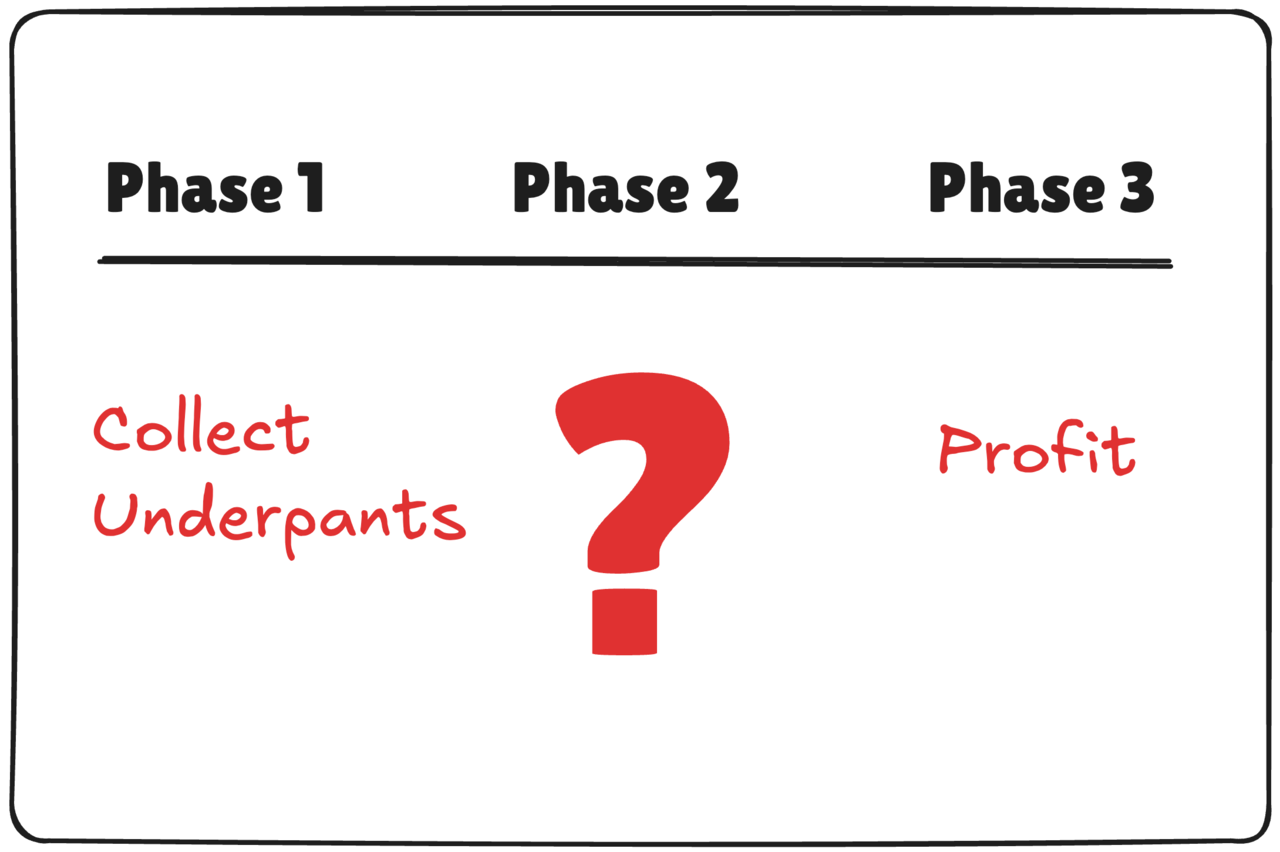Air Sandwich
An Air Sandwich plan (also known as an Underpants Gnomes Plan) contains lofty objectives and a detailed feature roadmap, but nothing in between. Such plans are typically misleading because there is no clear way to track progress apart from measuring effort, no way to challenge assumptions and no clear strategy to deal with unexpected problems.
There are several good ways to avoid an air sandwich, and they typically involve creating a hierarchical plan with clear leading indicators of value.
An Air Sandwich plan is caused by the inability of organizations to measure delivered value in the short-term, and effectively represents wishful thinking (such as “the revenue will significantly increase when these features are delivered”). Because there is no clear way to ensure that the proposed features actually contribute to the stated objectives, the delivery teams do not know if they are doing too little, too much, or if they are even working on the right things. Such plans lack one or both halves of the value exchange loop.
The Air Sandwich metaphor comes from Nilofer Merchant’s book The New How.
An Air Sandwich is a strategy that has clear vision and future direction on the top layer, day-to-day action on the bottom, and virtually nothing in the middle […] When a company has an Air Sandwich, the most valuable details and decisions that enable a strategy to succeed are left out of the strategy.
– Nilofer Merchant
Underpants Gnomes Plans
In “Gnomes”, the 17th episode of the second season of the animated TV series South Park, a group of gnomes sneak into people’s houses and steal their underpants. Pressured to explain why they are doing that, the gnomes always repeat that phase 1 of their master-plan is to collect the underpants, without being able to answer any questions about phase 2, yet insisting that phase 3 is “profit”.

The plan, along with the image of the gnomes presenting it, became a popular meme to mock bad business strategies. In effect, the Underpants Gnomes Plan is an air-sandwich, as the gnomes collecting underpants have no idea how that leads to profit.
Air Sandwich in product delivery
In product delivery, a common example of an Air Sandwich is a plan that contains a list of product features, without communicating the assumptions underlying the choice of those features. Even if such assumptions are documented somewhere else, they are not communicated to the delivery team members. As a result, delivery teams focus on the output of their work, not the outcomes for users or customers.
Another typical example is what Anthony Ulwick calls “customer-driven paradigm” in the book What Customers Want, where a delivery team is effectively just taking orders from business stakeholders or customers and delivering what people asked for, without evaluating what was actually needed. This delegates the responsibility for solution design to customers and business stakeholders, who rarely have the skills required to design good product solutions.
A common symptom of an Air Sandwich is that progress is measured purely with metrics related to effort (such as number of completed tasks or story point burn-down charts), leading to overconfidence and under-delivering. Effectively, this tracks only whether a solution is being delivered, not whether the problem is actually being solved.
How to avoid an Air Sandwich
Anthony Ulwick suggests that people “entrenched in the customer-driven paradigm” traditionally test solutions or features instead of jobs, outcomes and constraints when conducting research. A good way of avoiding Air Sandwich plans is to focus on testing outcomes (whether customers are doing the jobs they want to perform) instead of evaluating progress by measuring outputs (task completion by the delivery team).
The 4 Disciplines of Execution model explicitly requires stating both the wildly important goal and the leading indicators for achieving that goal, with the suggestion to formulate such indicators as behaviour changes. This helps to avoid the air sandwich as the behaviour changes help track short-term customer outcomes.
In the GIST model, each idea needs to be backed up by a pair of top-level metrics, one tracking the progress towards the business goal and the other tracking the delivery of value to the market. The second metric (“North Star Metric”) helps to avoid the air sandwich by directly communicating assumptions about the value delivered to users, and helps to track progress for that delivery.
Impact Mapping requires explicitly stating both the key milestone business goals and the impacts on individual actors, connecting them to deliverables in a hierarchy. That helps to avoid an air sandwich because the middle of the impact map (actor and impact) contain assumptions about short term value delivery to users or customers.
Now-Next-Later Roadmaps format requires explaining exactly which problem is being solved by a delivery item, and how it relates to product goals. This helps to avoid an air sandwich by stating value on both of those levels explicitly.
An Opportunity Solution Tree helps teams visualise various opportunities that could be exploited by the solutions, and assumptions underlying solutions, and helps to show the relationship between those and business objectives. The opportunities level in that visualisation is a direct way to avoid the air sandwich.
Learn more about the Air Sandwich
- Gnomes, South Park Season 2, Episode 17 (16 December 1998)
- The New How: Creating Business Solutions Through Collaborative Strategy, ISBN 978-1491903438, by Nilofer Merchant (2014)
- What Customers Want: Using Outcome-Driven Innovation to Create Breakthrough Products and Services, ISBN 978-0071408677, by Anthony Ulwick (2005)